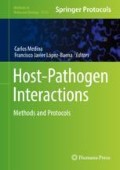Abstract
Constant advancements in methodology and mass spectrometry instrumentation, genome sequencing and bioinformatic tools have enabled the identification of numerous pathogen proteomes. Identifying the pathogen interacting proteins by means of high-throughput techniques is key for understanding pathogen invasion and survival mechanisms and in such a way proposing specific proteins as pharmaceutical targets. Herein we describe the methodology for the enrichment and identification of pathogen surface proteome using cell surface protein biotinylation followed by LC-MS/MS and bioinformatic analyses of such data. This strategy is to be employed for the determination of protein subcellular localization and prediction of potential pathogen interacting proteins.
Access this chapter
Tax calculation will be finalised at checkout
Purchases are for personal use only
References
Finlay BB, McFadden G (2006) Anti-immunology: evasion of the host immune system by bacterial and viral pathogens. Cell 124:767–782
Walters MS, Mobley HLT (2009) Identification of uropathogenic Escherichia coli surface proteins by shotgun proteomics. J Microbiol Methods 78:131–135
Elschenbroich S, Kim Y, Medin JA et al (2010) Isolation of cell surface proteins for mass spectrometry-based proteomics. Expert Rev Proteomics 7:141–154
Horvatic A, Kules J, Guillemin N et al (2016) High-throughput proteomics and the fight against pathogens. Mol Biosyst 12:2373–2384
Kules J, Horvatic A, Guillemin N et al (2016) New approaches and omics tools for mining of vaccine candidates against vector-borne diseases. Mol Biosyst 12:2680–2694
Elia G (2008) Biotinylation reagents for the study of cell surface proteins. Proteomics 8:4012–4024
Smith SM (2011) Strategies for the purification of membrane proteins. Methods Mol Biol 681:485–496
Lu X, Zhu H (2005) Tube-gel digestion: a novel proteomic approach for high throughput analysis of membrane proteins. Mol Cell Proteomics 4:1948–1958
Yu CS, Chen YC, CH L et al (2006) Prediction of protein subcellular localization. Proteins 64:643–651
Gardy JL, Laird MR, Chen F et al (2005) PSORTb v.2.0: expanded prediction of bacterial protein subcellular localization and insights gained from comparative proteome analysis. Bioinformatics 21:617–623
Wang J, Sung W-K, Krishnan A et al (2005) Protein subcellular localization prediction for Gram-negative bacteria using amino acid subalphabets and a combination of multiple support vector machines. BMC Bioinformatics 6:174–174
Huang DW, Sherman BT, Lempicki RA (2008) Systematic and integrative analysis of large gene lists using DAVID bioinformatics resources. Nat Protoc 4:44–57
Huang DW, Sherman BT, Lempicki RA (2009) Bioinformatics enrichment tools: paths toward the comprehensive functional analysis of large gene lists. Nucleic Acids Res 37:1–13
Dennis G, Sherman BT, Hosack DA et al (2003) DAVID: database for annotation, visualization, and integrated discovery. Genome Biol 4:R60–R60
Wisniewski JR, Zougman A, Nagaraj N et al (2009) Universal sample preparation method for proteome analysis. Nat Methods 6:359–362
Shevchenko A, Tomas H, Havlis J et al (2007) In-gel digestion for mass spectrometric characterization of proteins and proteomes. Nat Protocols 1:2856–2860
Acknowledgments
The authors acknowledge the European Commission for funding the VetMedZg ERA chair team (ERA Chair Initiative). We also acknowledge Croatian Science Foundation (project 3421) for supporting FM, HRZZ (project 4135) for supporting VM; and APVV-14-218, VEGA1/0258/15, and VEGA 1/0261/15 for supporting MB.
Author information
Authors and Affiliations
Corresponding author
Editor information
Editors and Affiliations
Rights and permissions
Copyright information
© 2018 Springer Science+Business Media, LLC
About this protocol
Cite this protocol
Horvatić, A. et al. (2018). Surface Proteome Biotinylation Combined with Bioinformatic Tools as a Strategy for Predicting Pathogen Interacting Proteins. In: Medina, C., López-Baena, F. (eds) Host-Pathogen Interactions. Methods in Molecular Biology, vol 1734. Humana Press, New York, NY. https://doi.org/10.1007/978-1-4939-7604-1_9
Download citation
DOI: https://doi.org/10.1007/978-1-4939-7604-1_9
Published:
Publisher Name: Humana Press, New York, NY
Print ISBN: 978-1-4939-7603-4
Online ISBN: 978-1-4939-7604-1
eBook Packages: Springer Protocols

